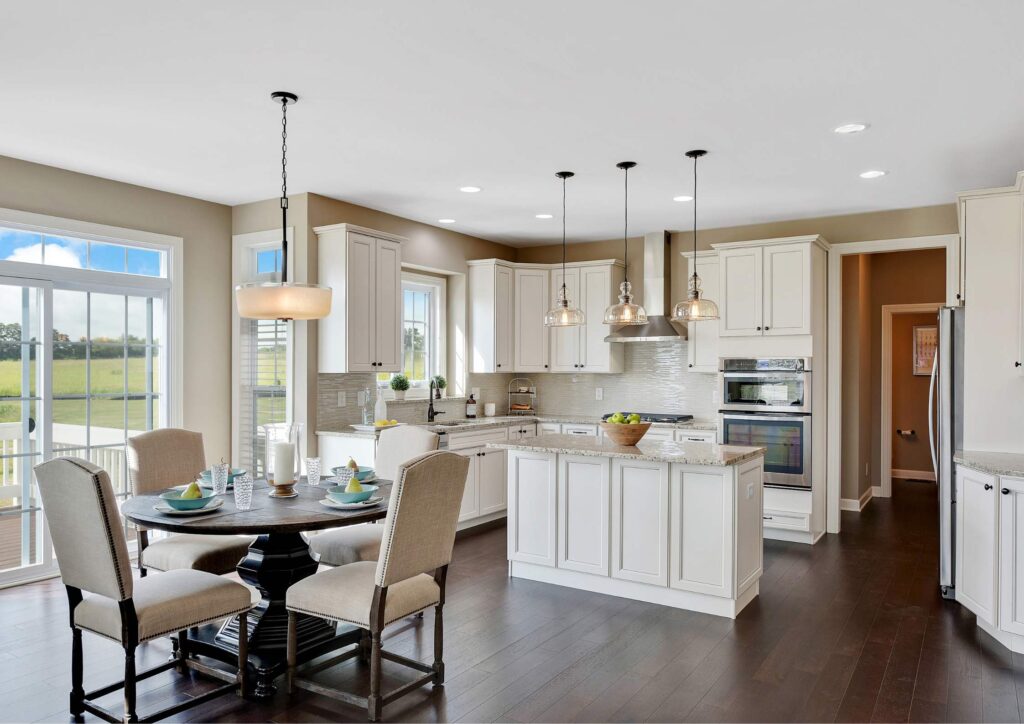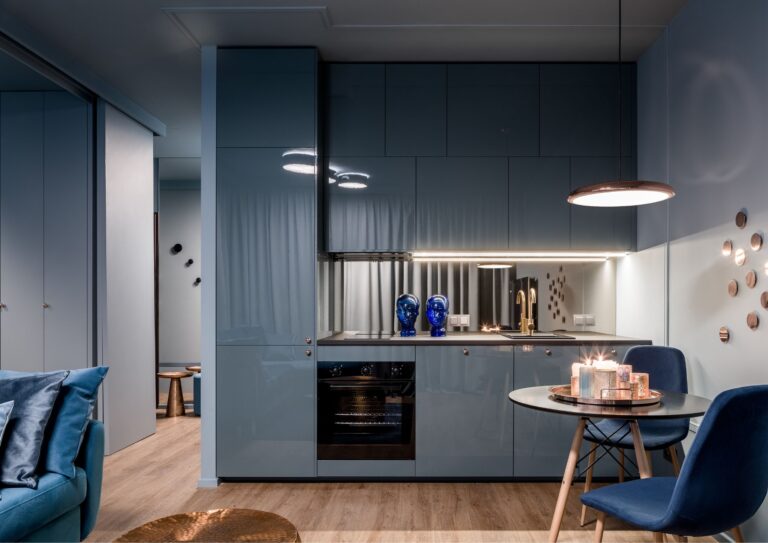The open kitchen concept has become increasingly popular in modern homes. One reason for this trend is space constraints; an open kitchen can make a small home feel larger and more functional. It also adds a touch of modernity and convenience, making it a desirable choice among various kitchen designs.
@ampquartzcabinets Do you a fan of Aluminum Kitchen? Aluminum kitchen cabinet is the most suitable for a wet kitchen! Buy 1, Free 11 within this November‼️ Interested? Get quote now! Link on Bio 🤗 #AMPQUARTZ #kitchencabinet #customcabinetjohor #wetkitchen
♬ original sound – Matthew Ifield
Open kitchens are especially beneficial for maximizing space in smaller homes. A well-designed open kitchen allows you to utilize every corner of your home effectively. Without walls, you can keep an eye on your kids and interact with guests while you cook, creating a more social and connected living space.
By removing walls and barriers, open kitchens seamlessly connect the kitchen with living and dining areas. This article will provide tips on creating a stylish and practical open kitchen, blending both aesthetics and functionality.
Tips To Create Open Kitchen 1 – Combine With Dining Room

Combining an open kitchen with your dining area is an excellent way to create a harmonious living space that promotes interaction and functionality. With no physical barriers, you can easily converse with family members while cooking or dining, enhancing the sense of togetherness.
Integrating these areas maximizes the available space, making your home feel more spacious and airy. Position your kitchen along an exterior wall if possible, as this arrangement often simplifies the design and organization of cabinets and appliances.
Consider the layout carefully to ensure efficiency. Place the dining area close enough to the cooking zone to maintain convenience but avoid positioning the dining table where it could obstruct movement while preparing meals. This thoughtful arrangement not only improves day-to-day functionality but also makes hosting dinner parties and social gatherings more enjoyable, allowing you to engage with guests while you cook.
Tips To Create Open Kitchen 2- Choose The Right Kitchen Layout And Design

Designing an open kitchen allows you to transform your home into a vibrant hub of activity and socialization. Choosing the right layout and design for this concept is crucial to maximize its benefits.
First, evaluate your space. The size and shape of your kitchen area will determine the possible layouts. Larger rooms offer more flexibility, while smaller spaces require careful planning.
Common layout choices for open kitchens include single wall, L-shaped, and peninsular island designs. These can be arranged along walls with sinks, cookers, and other appliances, making them ideal for open kitchens.
When planning your kitchen, consider its proximity to other areas of your home. If it's too close to seating areas, the noise from cooking might disturb daily activities. Ensure a balance between accessibility and comfort to create a functional and harmonious living space.
Tips To Create Open Kitchen 3- The Color Scheme

The colors you choose for your open kitchen play a significant role in setting the mood, style, and overall ambiance of the space. Your color scheme can greatly influence how both you and others feel about the room, making it a crucial aspect of your design process.
The primary goal of an open kitchen is to create a seamless flow from the cooking area to the dining space and finally to the living room. A well-thought-out color scheme can help achieve this harmony. Start by painting walls and large surfaces like cabinetry and countertops with neutral base colors such as white, beige, or soft gray. These neutral tones serve as a canvas, allowing other design elements to stand out.
@ampquartzcabinets Tutup mulut wak. Kalau awak nak jugak, meh sini datang AmpQuartz DM kita, or boleh datang showroom kita: 📍 82 Jalan Gaya 1 Taman Gaya, 81800 Ulu Tiram Johor (Waze: AMPQUARTZ) #AluminiumCabinets #6GAluminiumCabinet #HomeDecorMalaysian #kitchendesign #KitchenCabinets #KitchenCountertops #KabinetDapurJohor #KabinetDapurJB #KabinetDapurUluTiram #KitchenCabinetJohor #AMPQUARTZ
♬ suara asli – devi.fristiana – devi.fristiana
Introduce accent colors through kitchen accessories, decorative elements, and kitchenware to bring life and vibrancy into the space. Ensure that your open kitchen's color palette complements the adjoining areas to maintain uniformity and coherence throughout the home.
If you prefer a bolder approach, consider using deep blues, rich reds, or forest greens as accent colors against a neutral background. These bold hues can add a striking contrast and create a more dynamic and visually appealing space.
Tips To Create Open Kitchen 4- Meet The Lighting Needs

Lighting is a crucial element in any open kitchen design, enhancing visibility and creating a welcoming atmosphere. Carefully planning your open kitchen lighting can significantly impact the overall appeal and functionality of the space.
If natural light is available, make the most of it. Natural light eliminates darkness and creates a sense of spaciousness and warmth. Maximize natural light by incorporating as many strategically placed windows as possible, ensuring that light is evenly distributed throughout the room.
For artificial lighting, choose ceiling fixtures such as flush-mount or pendant lights over the kitchen island or dining area to add style and visual interest. If your countertops cast shadows while preparing food, consider installing under-cabinet lighting. Puck lights or light bars can provide additional illumination, ensuring your workspace is well-lit and functional.
By combining natural and artificial lighting effectively, you can create a bright, inviting, and efficient open kitchen that enhances the overall ambiance of your home.
Tips To Create Open Kitchen 5 – Broken-plan layout

A broken-plan layout is a contemporary and innovative approach to designing open spaces, including open kitchens. Unlike traditional open-plan designs that feature minimal divisions, a broken-plan layout introduces subtle partitions or design elements to create a more functional, personalized, and aesthetically pleasing space.
The goal of a broken-plan layout is to create distinct yet interconnected areas within an open space. This allows you to have separate sections for cooking, dining, and relaxation, each with its own unique ambiance.
This design approach helps you organize your kitchen based on functionality. For instance, you can group all cooking appliances in one area, place dining furniture in another, and create a cozy lounge space elsewhere in the kitchen.
@ampquartzcabinets Poket tak tebal tapi imagination untuk dapur tu bukan main tebal ya 👀 Jangan lah risau! Kitorang sekarang ada material melamine juga tau. So, design dapur Muji korang dengan AmpQuartz harini! Call je! 📞 +6017 732 0149 (Jasmine) +6010 707 7815 (Lekha) +6010 719 7191 (Hema) https://go.wa.link/ampquartz #MelamineCabinets #MelamineKitchenCabinet #ParticleBoardCabinet #HomeDecorMalaysian #kitchendesign #KitchenCabinets #KitchenCountertops #KabinetDapurJohor #KabinetDapurJB #KabinetDapurUluTiram #KitchenCabinetJohor #AMPQUARTZ
♬ original sound – AmpQuartz – AmpQuartz
Different floor materials can visually demarcate various zones within the open space. For example, you might use tiles in the kitchen area and hardwood in the dining or living areas. Proper furniture placement is also crucial for defining these zones; a strategically placed sofa can effectively separate different functional areas.
The broken-plan layout offers homeowners the best of both worlds: the spaciousness of an open plan combined with the functionality of defined zones. This versatile design approach allows you to create a kitchen that meets your specific needs while maintaining a cohesive and stylish overall look.
Essential Tips for Your Open Kitchen Design
Designing a stunning open kitchen requires thoughtful planning and strategic execution. By seamlessly integrating the kitchen with the dining area, you create a balanced living space that promotes interaction and usability.
Choosing the right kitchen layout is crucial for maximizing the benefits of an open concept. Whether you opt for a single wall, L-shaped, peninsula, or island design, each can be tailored to fit your space and needs. A harmonious color scheme that extends to adjoining areas enhances the seamless flow and cohesion of the space.
Lighting plays a vital role in both functionality and aesthetics. A mix of natural light, ceiling fixtures, and under-cabinet lighting ensures the kitchen is well-lit and inviting. Embracing a broken-plan layout can introduce subtle divisions, creating distinct functional zones within the open space and offering a contemporary, versatile design.
These transformative tips will ensure your open kitchen is not only visually appealing but also practical and conducive to socializing and everyday activities.





